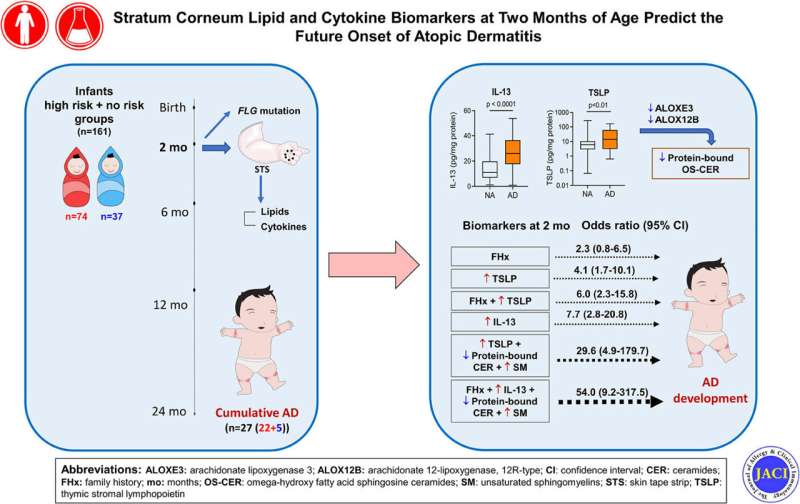Credit: Journal of Allergy and Clinical Immunology (2023). DOI: 10.1016/j.jaci.2023.02.013
Researchers at National Jewish Health have identified an immune and lipid profile on the surface of the skin of infants that can predict the development of atopic dermatitis, or eczema, months before the onset of clinical illness. Atopic dermatitis affects 20-30% of children worldwide. Atopic dermatitis commonly occurs in children and can progress into what is called the atopic or allergic march, which refers to the progression of diseases that often begin early in life. Once the skin rash occurs, food allergies, asthma, and other problems can develop.
"The holy grail to deal with atopic dermatitis is to prevent it," said Donald Leung, MD, Ph.D., division head of Pediatric Allergy and Clinical Immunology at National Jewish Health and senior author of the study published today in the Journal of Allergy and Clinical Immunology. "It tends to come back when you treat it, so we really have to examine how to avoid getting it."
Researchers partnered with hospitals in Korea, where physicians there used non-invasive skin tapes on the forearms of babies who were two months old, before signs of clinical atopic dermatitis typically present. The study participants included those with and without a family history of atopic diseases.
Babies were clinically monitored from birth until they reached age two. Their skin cells were collected beginning at two months of age, and were analyzed by mass spectrometry in the laboratory of Evgeny Berdyshev, Ph.D., lead author of the study and the head of the mass spectrometry laboratory at National Jewish Health who pioneered this analytical assay.
"In order for us to introduce an effective preventative therapy, we must know the skin abnormalities before patients develop clinical rash. Now that we've discovered the biomarkers IL-13 and TSLP, we can find ways to prevent eczema by using targeted therapies, such as emollients or other biologics," said Dr. Leung.
"The disease begins because the skin barrier is leaky and allows allergens to come in through the skin. An abnormal skin barrier doesn't protect a patient from environmental hazards."
Researchers at National Jewish Health began using the painless, round skin tape on babies about 10 years ago. Prior to that, dermatologists performed painful biopsies on the skin. Offering this new option increased the number of people willing to participate in these groundbreaking studies.
More information: Evgeny Berdyshev et al, Stratum Corneum Lipid and Cytokine Biomarkers at Two Months of Age Predict the Future Onset of Atopic Dermatitis, Journal of Allergy and Clinical Immunology (2023). DOI: 10.1016/j.jaci.2023.02.013
Journal information: Journal of Allergy and Clinical Immunology
Provided by National Jewish Health
























